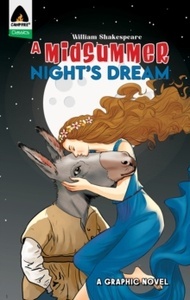A Midsummer Night's Dream : A Graphic Novel

Editorial Campfire
Fecha de edición noviembre 2022 · Edición nº 1
Idioma inglés
EAN 9789380741567
88 páginas
Libro
encuadernado en tapa blanda
Dimensiones 260 mm x 165 mm
Resumen del libro
This graphic novel adaptation of Shakespeare's famous comedy retains the original language while the charming illustrations make the text more accessible for readers being introduced to the great dramatist's works for the first time.
A concise, highly enjoyable adaptation of the classic play; one of more than 85 titles Campfire has published since their introduction to North America in 2010.
At the dawn of Western civilization in ancient Athens, a young lady named Hermia has threatened to upset the order of things by announcing that she will marry the man she loves, rather than the man that her father has chosen for her. Theseus, Duke of Athens, asks, "How shall we find the concord of this discord?"
Join Shakespeare as he offers us a classically entertaining solution to this problem. Under pain of death, Hermia flees Athens and spends a mad Midsummer night along with her friends along with other city-dwellers in a nearby forest. Unbeknownst to the Athenians, the forest is inhabited by a legion of fairies and the mischievous hobgoblin Puck. The fairies' misguided attempt to help out the humans with a magical herb leads to mayhem. As the buffoon Bottom says, the night in the forest becomes "a dream, past the wit of man to say what dream it was".
ver menos
Biografía del autor
William Shakespeare fue un dramaturgo y poeta inglés, considerado uno de los más grandes escritores de todos los tiempos. Hijo de un comerciante de lanas, se casó muy joven con una mujer mayor que él, Anne Hathaway. Se trasladó a Londres, donde adquirió fama y popularidad en su trabajo; primero bajo la protección del conde de Southampton, y más adelante en la compañía de teatro de la que él mismo fue copropietario, Lord Chamberlain's Men, que más tarde se llamó King's Men, cuando Jacobo I la tomó bajo su mecenazgo. Su obra es un compendio de los sentimientos, el dolor y las ambiciones del alma humana, donde destaca la fantasía y el sentido poético de sus comedias, y el detalle realista y el tratamiento de los personajes en sus grandes tragedias. De entre sus títulos destacan Hamlet, Romeo y Julieta, Otelo, El rey Lear, El sueño de una noche de verano, Antonio y Cleopatra, Julio César y La tempestad.Shakespeare ocupa una posición única en el mundo, pues sus obras siguen siendo leídas e interpretadas en todo el mundo.








